

As in previous years we will break the outward and return journeys to visit some outstanding gardens en route. These include Wood End Cottage in Cheshire, a gem of a garden owned by HPS members Chris and Maurice Everett, and nearby Arley Hall, famed for its herbaceous borders. On the return journey we hope to visit Gresgarth Hall, the home of garden designer Arabella Lennox-Boyd, whose garden is frequently featured in the gardening press. The tour will be rounded off with a stop at the garden of staunch HPS members Dennis and Susan Watson outside Preston.
In Cumbria itself the pace will be more leisurely with plenty of time to enjoy the chosen gardens and talk to their enthusiastic owners. There will be a mix of important gardens like Levens Hall with its dramatic and entertaining topiary and private gardens such as Pear Tree Cottage, Summerdale House, Greencroft House and Hazel Cottage. The home of the Lakeland Horticultural Society, Holehird Gardens, with its fine views over the hills of the Lake District, is also on the itinerary, as are two highly recommended local nurseries. This part of the country enjoys a relatively mild climate for its northerly latitude. Combined with a high rainfall this produces lush growth and enables many plants to flourish that would struggle in our gardens further south. Members can look forward to seeing some lovely gardens.
All the gardens to be visited in Cumbria are within easy striking distance of our chosen hotel, the Castle Green Hotel, which is situated in a quiet location on the outskirts of Kendal with views out over the hills. This is a 3-star hotel operating under the Best Western banner. The rooms have been inspected and are modern, comfortable and well-appointed. For the more active members there is a gym and swimming pool and a pub for the rest of us. All the rooms are twin- or double-bedded, even if let for single occupancy.
The total cost of the tour is £400 per person based on two sharing a twin/double bedded room. There is an additional charge of £80 for single occupancy. The price includes travel, coach driver’s gratuity, accommodation on a dinner, bed and breakfast basis, all garden entrance charges, a number of which include refreshments, and a buffet lunch on the penultimate day.
I knew this was going to be a really good tour when we approached the first garden, the sun came out and I could see the characteristic blue of a Himalayan poppy on the bank of a stream - both features which appear high on my wish list.
Wood End Cottage is owned by Chris and Maurice Everett and although not a large garden it contained a range of plant habitats, from dry beds close to the cottage to damp stream-side, via lush island beds. The garden used to open regularly under the NGS, but now only opens for private parties.
We were too early for the roses and collection of Phlox which are features of the garden, but there was still plenty of interest including a fine specimen of Cornus kousa which along with the meconopsis were to be highlights in many of the subsequent gardens and remain significant memories. I was particularly struck by the lushness of the plants with astrantias about twice the size of mine. There were also some fine oriental poppies including a lovely deep red double with a dark centre - Papaver orientale 'Heartbeat'.
The wide variety of plants in this garden would I think promise plenty of interest throughout the year and was a very enjoyable first visit for the tour. Fortified by the first of many cups of coffee and pieces of cake we progressed to Arley Hall.
The next garden we visited was a complete contrast in scale, history and planting.
I began by walking around the seven acres of The Grove and Woodland Walk noting the many different species of trees and shrubs. There are over 300 different rhododendrons, with flowers in a wide variety of colours. Unfortunately, some were past their best but I could still appreciate their colours and scent. Lots of other trees and shrubs had been planted in this area resulting in shady with a typical woodland flora , such as ferns and bluebells (now over). The large Handkerchief Tree Davidia involucrata was a spectacular sight.
The main part of the garden consists of about eight acres of gardens laid out in different styles. The Flag Garden had a pagoda covered with clematis. Nearby were the small Scented Garden and the Herb Garden. What is now the Kitchen Garden was mainly laid out to lawns with a delicate white wire arbour in the centre decorated with urns and pinnacles. At one side was the Victorian Vinery which had been restored recently. There were no vines in it but there were many tender plants and some fig trees. A pity it could not be returned to its original use.
A notable feature of this garden were the very colourful Herbaceous Borders, both were backed by well trimmed yew hedges planted in 1856. These double herbaceous borders are thought to be some of the earliest to be planted in England, being started in about 1790.
The Walled Garden was originally the kitchen garden for the house, providing a supply of fruit and vegetables. It was redesigned in the 1960s. There were four areas of lawn with a pond in the middle which had a modern sculpture of a flower in it. To me this did not seem to go very well with the rest of the garden. Some of the walls still had fruit trees from the original planting trained up them, other parts of the walls had more recent plantings of attractive ornamental trees and shrubs flowering and fruiting at different times of year.
The Ilex Avenue was an unusual feature consisting of seven pairs of evergreen oak Quercus ilex planted in 1850. They are clipped into 8 metre high cylinders, quite a sight. It must be quite a challenge to keep them looking so immaculate.
There were several small gardens beyond the Ilex Avenue. These included the Fish Garden created in the 1920s and reflected the taste at the time for sunken gardens. The Rootree was laid out in the 19th century to resemble a miniature mountain landscape with hills, rocks, pool and even a grotto. More recently scented azaleas had been planted, which did not seem to be quite right somehow.
At the end of the Ilex Avenue I reached the Sundial Circle. The sundial is on a pedestal and overlooks the ha-ha and then the fields of the park. On the day we visited the local dog show was being held there, with a rather loud and intrusive tannoy. Many of us felt this reduced our enjoyment of these historic gardens to some extent.
We visited grand gardens, dramatic gardens, old gardens, famous gardens and an 'alternative' garden, but the one I really didn't want to leave was Pear Tree Cottage, sitting just as it should under the wooded hill and minor road and looking south-west over the neighbouring farm.
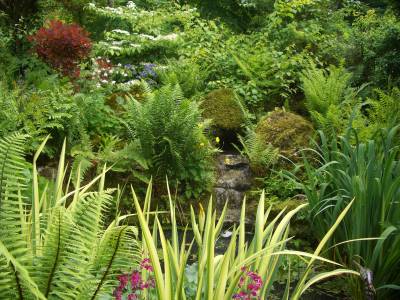
Owners Linda and Alec had had drama – Alec in a bad traffic accident in Thailand and flooding across the clay bed in the centre of the garden.
The main herbaceous borders surround the lawn - veronica, alliums, delphiniums, astrantia and thalictrums, including a marvellous tall one with cream flowers and dark stems – Thalictrum 'Anne'? - can someone enlighten me? Meconoposis had already become a theme of the tour and geums became a second one for me. Some of Linda's come from a grower near Penrith who breeds them: 'Eden Valley Angel' was a beautiful soft peachy-cream. Roses were limited to two big magenta shrubs and one smaller one with small pink flowers.
Trees border the garden on two sides and Linda has planted Liriodendron chinensis, Gingko biloba, and Metasequoia 'Gold Ruby' in the garden – all still small now. Water runs gently through a dell of mossy rocks with ferns, Primulae bulleyana, beesiana and florindae as well as Iris pseudacorus.
Ferns are Alec's passion - he has 150 varieties, some to him 'ordinary', but some completely extraordinary, such as the not hardy Pteris cretica. Polystichum setiferum plumorosa devorun was given to Alec by a friend whose grandfather gave it to him; Thysopteris elegans grows in the wild on one square mile on Robinson Crusoe Island off Chile - Alec's specimen is an ex-conservation plant from Glasgow Botanic Gardens and, eight years later, he is now growing some from spore.
In contrast to the lushness is a gravel bed where Amsonia ciliata and dodecatheon grow; the outhouse roof is a dry garden of sedum and armeria, and a rockery faces out below the most south-facing side of the house.
Linda doesn't like 'hot beds' and wanted a garden which was a bit more 'garden-y' near the house, then with shrubs and finally trees shading into the wood. She's certainly achieved this – to me, Pear Tree Cottage could be nowhere else and nothing else would be as 'right' for this patch of Cumbria.
Monday morning dawned bright and dry. 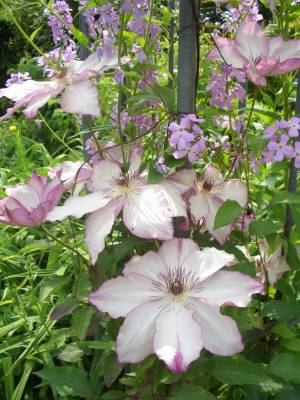 Our second visit of the day was to Summerdale House just after a very nice lunch stop. A warm welcome was given by the owners, Mr & Mrs Sheals, and she stressed the kettle would be on and homemade cake available in the courtyard. Built on a quite steeply sloping site of an acre and a half, the 18th century former vicarage stood in the middle. A narrow walkway around the back of the house past a large white wisteria led to the formal area outside the front door. Neatly mowed lawns, box balls and small areas off to the side, each with a seat to sit and contemplate for a moment. At the garden’s lowest point was a pond garden, cool and green, with acers, ferns and Trollius ‘New Moon’ flowering with tissue paper thin cream petals. It sent quite a few of us to the nursery area to seek one out. They ran an extremely well stocked nursery. A shade tunnel filled to bursting with candelabra primulas in all colours had many of us reaching for our cameras.
Our second visit of the day was to Summerdale House just after a very nice lunch stop. A warm welcome was given by the owners, Mr & Mrs Sheals, and she stressed the kettle would be on and homemade cake available in the courtyard. Built on a quite steeply sloping site of an acre and a half, the 18th century former vicarage stood in the middle. A narrow walkway around the back of the house past a large white wisteria led to the formal area outside the front door. Neatly mowed lawns, box balls and small areas off to the side, each with a seat to sit and contemplate for a moment. At the garden’s lowest point was a pond garden, cool and green, with acers, ferns and Trollius ‘New Moon’ flowering with tissue paper thin cream petals. It sent quite a few of us to the nursery area to seek one out. They ran an extremely well stocked nursery. A shade tunnel filled to bursting with candelabra primulas in all colours had many of us reaching for our cameras.
On the steep part of the slope an old orchard dated back to the house’s beginning with spotted orchids in the grass. Bark paths curved up and around shade loving plants up here. Magnolias, azaleas and rhododendrons provided vivid splashes of colour and scent. Ferns, hostas and foxgloves in abundance. Again, seats to give views over the countryside to Long Crag in the distance. A summer house at the very top, which was at the same level as the first floor windows of the house, and two formal ponds with gunneras, meconopsis and iris siberica – cool shades of blue.
Tea was served in the courtyard at the side, a little auricula theatre packed with pots added to the atmosphere, and the cake as always was delicious.
I wanted to visit Levens Hall since about 2000. This was the year I bought a painting by Giles Winter of the topiary gardens and, as it is hung in our hall, each time I pass it I wondered if any garden could look as strange as the one he had painted in great detail.
It proved to be just so, but the topiary garden is a small part of the total eight acres of formal gardens. Due to the late spring we visited the topiary gardens just as they were changing the under-planting so we did not view it at its best. I felt there could have been better signage round this section of the garden as it was difficult to recognise or understand the meaning of the shapes.
However, the garden had many other beautiful areas. The borders round the house were full of majestic plants - Cardiocrinum giganteum was the one that I noticed due to my failures! The blue and white borders, followed by the burgundy borders were full and busy. In contrast the Fountain pool and surrounding beech hedges gave a great feeling of peace. Children would love the willow maze with magic hare in the middle and the play area, which rejuvenated the weary Plant hunter. If the family were not too keen on children, they hated smokers. In the most remote corner of the garden beyond the play area was the 17th century smoke house where the unfortunates were banished too for their pleasure.
Still puzzling why Giles, who normally paints railway engines, painted the topiary garden, I came upon Bertha, and all was explained. Even a hardened railway enthusiast could be swept away by the theatre of Levens Hall.
After lunch in Windermere we travelled a short distance to Holehird. This was a garden I was especially looking forward to visiting as I had read a number of articles about it, describing how it was managed by volunteers and held three Plant Heritage National Plant Collections. Although it now no longer holds the Hydrangea collection it has recently been awarded National Collection status for blue meconopsis.
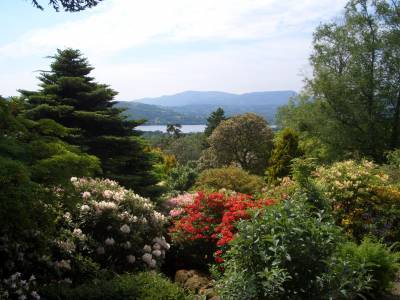
The afternoon was warm and sunny, perhaps even a little too warm after the long walk up a steep incline and through a Mediterranean type planting to the walled garden, where the reception area and plant sales were located. The garden was set in glorious Lakeland scenery and was surrounded by hills. We entered through a gate into the walled garden which was laid out with beds along each of the four walls and island beds in the middle. A patio area with alpines and herbs was situated next to the north wall. The beds were full of interest and all the plants were well grown and labelled. Several caught our attention including Aesculus x mutabilis ‘Induta’ which was covered in flowers, Ranunculus aconitifolia ‘Flora Plena’ and Lilium mackliniae.
On reaching the end of the west border we went out of the walled garden and up to the paddock where there were trial beds containing some wonderful Meconopsis baileyi (betonicifolia) in many shades of blue. We were told that one of the volunteers was interested in this genus and had built up the collection. We were lucky that it was a late spring and the meconopsis were at their best. (We were to see an even better display of these plants the next day.)
We walked back around the outside of the walled garden to the rock garden passing a row of neatly stacked wheelbarrows at the rear of the potting sheds. The rock garden is in a part of the property known as Fellside which is an area of the original garden that has been renovated by the volunteers. There were many interesting trees and alpines growing here and a lot more time was needed to examine them all. (The other National Collection held by Holehird is the fern Polystichum, which was located at the top of Fellside but we didn’t have time to see it.) We were enchanted by some flowers on a water plant which was growing in small pool situated in the rock garden. They looked like a cloud of small white butterflies and were the flowers of Aponogeton distachyos, the Water Hawthorn.
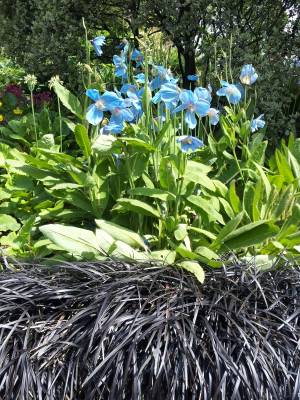
We moved down to the meadow area where there was a magnificent handkerchief tree Davidia involucrata var. vilmoriniana covered in the white ‘hankies’ that give the tree its common name. This was where we found the National Collection of Astilbe (over 200) which looked very healthy but were not in flower, although they were in bud. The shop later provided a postcard and leaflet showing them in full flower. A long bed of hostas was located at the edge of the meadow and were looking very good. It was here we found another blue meconopsis, Farrer’s Harebell Poppy, M. quintuplinervia, which was very pretty.
Leaving the meadow we came to the Alpine and Tufa glasshouses where some very attractive alpine plants that needed protection were to be found, Erinacea anthyllis in the Tufa house was covered in flowers.
After some very speedy refreshment we started on our way back to the car park by walking through the lower garden. We stopped to enjoy the Dale Panorama view, looking out to Langdale fells, before going down along the side of the cascade where there was a primula with red flowers that caught our eye and was called Hugh’s Red. The path went along the terrace passing the arbour and hydrangea bed (not in flower) where the National Collection had been situated, then back to the car park.
This account of the garden is very brief because of limited space but if you get the chance, do visit this wonderful garden. I was certainly not disappointed with my visit, with every part of the garden having something to exclaim over, but feel that at least a day is needed to see it all properly. It is certainly a credit to the volunteers who maintain it and the National Collections, besides providing among other things a visitor centre, library and lectures.
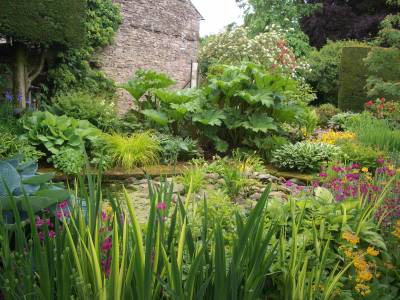
This garden was created 35 years age from farmland. It surrounds the house and has an area of trees, shrubs and ferns leading to four square beds with a sundial in the centre. The planting in the beds is changed regularly with flowers and vegetables taking their turn. An arch in the hedge leads onto a lawn behind the house with a lovely open view over the countryside. A central statue, at the time of our visit, was surrounded by closely-planted blue/grey leaved hostas, simple but very effective. Then, through another arch and onto a lawn with beds round the edges and two central beds all densely planted. Most striking here were the number of blue and white meconopsis and the number and variety of coloured primulas. Moving round to the front of the house, there were more hostas and a pond with water running into it over a ledge. More meconopsis, this time a soft lilac/pink, and onwards to a delightful area of alpine plants nearly all in flower. Throughout the garden there was well-placed statuary, the extensive hosta collection was in perfect condition, and the skilful planting and use of colour were most impressive. A very enjoyable visit.
Oh my! This was different. We arrived at Hazel Cottage to be greeted by John Thexton - grinning from ear to ear – announcing with a most glorious north country dialect that “the garden was little unkempy”! His friend and co-owner of the property, David, was away doing a floral demonstration, so all was left to John to show us round the 28 acres of an old stud farm, part of which the two of them developed into a garden to produce flowers and foliage for their floral art. The garden, on a steep slope and bordered by a disused railway line, may have been a little ‘unkempy’, but it was stuffed full of choice flowers and shrubs.
As we were mulling over plants for sale, a bell sounded and we were ushered into tea, enjoying a full run of their home, John producing tea and delicious cakes and eager to answer any questions. Judging by the photos around, the equine beasts played a big part in their lives, but they were also available to take on gardening jobs, choosing only those where no hard labour was required, eg ground elder, but accepting those where any choice plants were lurking.
If this wasn’t enough, we were then moved into a barn where John proceeded to demonstrate two floral decorations accompanied by non-stop banter. He was amazing. I bought a variegated horseradish which has been nurtured during the dry summer, but at present looks anything but variegated – perhaps next year similar to variegated honesty. Here’s hoping. Thank you David – a clever choice!
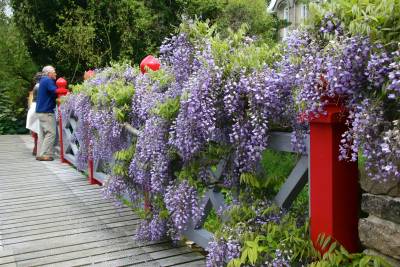
Four full-time gardeners supply the horticultural muscle and know-how that keeps the main 15 acres of Gresgarth garden in such fantastic shape.
It’s the Lancashire home of garden designer Arabella Lennox-Boyd and her husband, former Conservative MP Mark, and is open to the public just one day a month, usually a Sunday. The Worcestershire Hardy Plant Society group of 48 were its only visitors on that Friday in June 2013, and what a privilege it was to be there.
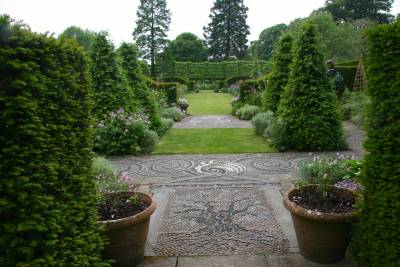
Everywhere there was a refreshing contrast between the formal and the informal - with sharp, crisp edges of mown paths through long grass, neatly clipped yew hedges galore and frothy, tumble-down herbaceous planting to delight the eye.
The design and planting of the garden is the result of the encyclopaedic mind of Arabella – and her attention to detail. Thoughtful touches everywhere were the hallmark of this gorgeous garden - including the garden insect designs in the paths of the kitchen garden, the thoughtful placing of works of art throughout the garden, the Serpentine walk and the colours and designs of the bridge across the Artle Beck, a tributary of the River Lune.
And, the best thing about visiting such a fertile seed-bed of ideas, I’ve stolen one of her approaches for my own garden. It’s the planting of Camassia ‘Semi-plena’ in areas of long grass. It was a ravishing sight that has stayed with me ever since. My bulbs have arrived this week – another job to add to the never-ending list of autumn garden work.
Last, but not least. A warm welcome awaited us at Wedgwood, the home and garden of Sue and Denis Watson. Sue informed us that she and Denis purchased Wedgwood 17 years ago in 1996 – one acre consisting of house, lawn, old trees, stables, packing shed and three paddocks.
The garden is now divided into four separate areas, the house garden being the first area to be tackled. The hedge and 100 trees and shrubs were planted to create a shelter belt as the garden is at sea level and only half a mile from the Irish Sea. It is now a mature garden with shady areas containing hostas, hellebores, spring flowering shrubs and a well tended lawn. The colourful summer borders were full of cottage garden perennials old and new. The new to me and several members was a Lychnis miqueliana with maroon coloured leaves and dusky orange flowers. Did I buy one? Yes I did – and so did several others. (It’s not reliably hardy, but readily sets seed which Sue said germinates easily). So, there should be some plants on the sales table next year.
The second area has old brick stables, a large packing shed and the plant sales area, and yes it was the first place some keen members visited. The huge commercial glass house, some 50’ x 60’, is the working hub of the garden. It is here that all the propagation takes place and all of the annuals from seed are raised. A collection of geraniums in lovely old terracotta pots plus a fig tree and many more tender climbers decorate the supporting structure, and most importantly the refreshments were available here.
The Rainbow Garden, a parterre begun in 2002, was the third area to be instigated, an area 90’ x 90’. Denis, with the help of friends, erected the substantial wooden structures - gazebo, pergolas, arches and wigwams – which are the backbone of the garden. The gazebo in the centre is clothed in clematis, roses and golden hop and is surrounded by nine separate planting sections of different colours, white through to orange and purple, each bed with a wigwam planted up to match the bed colour: red – red sweet peas, green – runner beans etc. Grasses were used to good effect at the perimeter. Sue raised most of the plants and had some help from local nurserymen who sourced and donated plants and cuttings. The Rainbow Garden is now mainly perennials with annuals for added colour, and is Sue’s favourite place to be and work.
The fourth area is a meadow with fruit trees and mown paths meandering through – a tranquil spot after the kaleidoscope of colour in the Rainbow Garden.